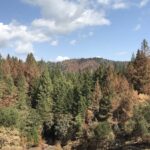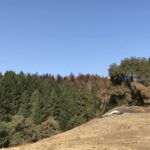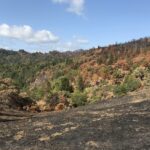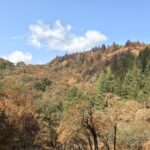November 30, 2020
Posted in: News Articles
Pryor Ranch and the impacts of the Walbridge Fire
As wildfire season winds down and we transition to winter, we are reflecting on what we can learn from this year’s fires as we continue our preparedness and resiliency work. As with all of the fires in the last few years, the Walbridge Fire impacted several properties protected by Ag + Open Space conservation easements. Pryor Ranch, a 1,500-acre privately owned property located west of Windsor and north of Guerneville that was protected in 2011, lies with the Walbridge burn perimeter.
Though the entirety of Pryor Ranch was burned by the Walbridge Fire, you can see in the photo below how minimal the impacts to the canopy were across much of the property – meaning a substantial portion of the larger, older trees proved to be quite fire resilient. While parts of Pryor Ranch did see more active fire behavior than that pictured below, for the most part the fire didn’t transition to a crown fire, or a fire that spreads from treetop to treetop.
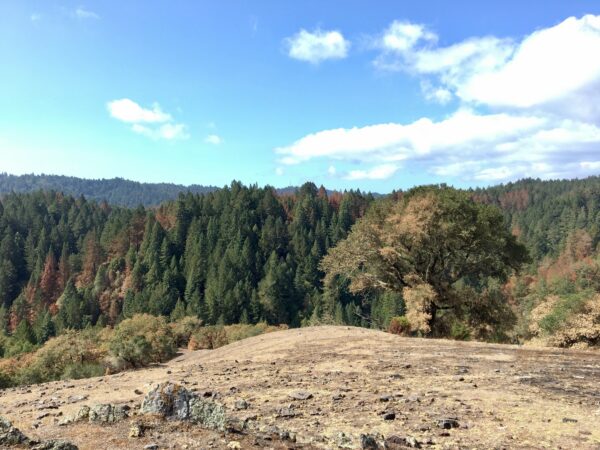
Pryor Ranch after Walbridge Fire, September 2020.
Although this area hadn’t burned for at least 70 years, it is possible the landowners’ forest stewardship and selective tree harvesting may have created more open forest conditions, which could have contributed to the fire staying primarily on the ground, away from the canopy. The few areas of the property that did experience crown fire were limited in size and confined mainly to ridgetops where drier site conditions, pre-heating of fuels as fire moves upslope, and alignment with winds during the fire event typically results in more intense fire behavior and heavier impacts to trees.
While small areas of higher-intensity fire can play an important role in creating gaps in the forest canopy, allowing shade-intolerant species to thrive and creating higher diversity of plant species and habitat areas, extensive crown fire is undesirable for many reasons. It typically results in very high tree mortality, and may leave few to no surviving trees to act as a seed source for forest regeneration. These areas may be prone to soil loss, mud or rock slides, invasion by weedy species, and in the long-term could become home to plant communities that may provide fewer benefits in terms of habitat value, carbon storage, and sustainable timber yield than healthy forests.
From a safety standpoint, when fires progress to the canopy and become crown fires they can spread more rapidly than fire on the ground, and can be much more difficult for firefighters to suppress and contain. Encouragingly, on this property and throughout the majority of areas that have burned in our county in the past several years, the fires appear to be remaining on the ground most of the time.
Thankfully, due to effective fire suppression efforts and the landowners’ work to create defensible space, the fire didn’t destroy any structures on the ranch, but it did impact some of the timber on this working forest, and the landowners are now looking at doing a limited salvage harvest of some of the trees that were killed by the fire. As sustainable commercial timber harvest is permitted on this property and provides necessary income for the landowners’ management of the property, this harvest would enable the landowners to prevent some of the revenue losses due to the fire.
The harvest would occur within a few relatively small areas that were heavily impacted by the fire, would leave some trees and snags (standing dead trees) for habitat and as a seed source, and would be followed by conifer tree planting to restore these areas to pre-fire conditions. Ultimately, removing these dead trees should set the stage for the renewal of healthy, fire-resilient forest that will continue to provide habitat for native plants and animals while enabling the landowners to derive some income from the property.
The conservation and careful stewardship of this property through a partnership between the landowners and Ag + Open Space proved helpful in the face of wildfire. We are still in the process of understanding more about why the fire behaved as it did on this particular property, but these early observations have helped reinforce the importance of land conservation and stewardship in the face of climate change and increasing wildfire activity.
